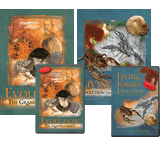Bird’s Nest Fungus—High-Flying Eggs!
The forest is full of unseen wonders. Consider just one common type of fungus on the forest floor. It produces a nest of “eggs”—and that’s just the beginning of this crazy story. The eggs actually “fly”!
Some people just can’t get enough fungi—stuffed, sautéed, or even raw on salad. Others can’t stand the fuzzy stuff that grows on dead things. Otherwise, we don’t pay much attention to these earthy protuberances. Why are we so often blinded by our busyness to stop and indulge our childlike curiosity?
“The works of the Lord are great, studied by all who have pleasure in them” (Psalm 111:2). Take, for instance, the bird’s nest fungus of family Nidulariaceae. This impressive little organism is common throughout the forests of North America and the rest of the world. But unless you pay close attention, you’ll probably overlook this little gem on the forest floor, nestled on a shady patch of rotting wood. It looks, for all the world, like a cluster of eggs in a miniaturized nest.
Each nest has several discs (.04–.11 in. [1–3 mm] in diameter), bearing some resemblance to bird’s eggs. It doesn’t look anything like the familiar mushroom, so you might dismiss it as a UFO (unidentified fungus object). But once you understand the purpose behind this strange shape, you’ll have another reason to talk about the Creator’s wonderful design.
How Do the Spores Get Launched?
Most fungi depend on outside forces, like wind and animals, to disperse the next generation. But this fungus boasts a one-of-a-kind dispersal mechanism.
Inside the “eggs,” technically known as peridioles, are microscopic spores. Each egg is surrounded by a delicate membrane that eventually rips open to release the spores. So why are the spores sitting inside a cup?
The impact of a raindrop launches the eggs out of the nest to germinate nearby.
When a drop of rain hits the cup (actually called a splash cup), the impact launches the eggs up and out. This is similar to cereal leaping out of your bowl when you dump in the milk too quickly. Unlike cereal in a bowl, the eggs are much lighter and smaller, and the walls of the cup are very steep. One raindrop can splash the “eggs” several feet into the air.
That’s not the most astonishing part. One notable group of bird’s nest fungus, the genus Cyathus, has an additional trick up its sleeve—literally.
Attached to each egg is a long coiled thread with a sticky end tucked in a tear-away sleeve (Figure 1). When a raindrop falls into the cup and hurls the “egg” through the air, the cord is unleashed from the torn sleeve, straightening out several inches. If the cord brushes against a twig, the sticky end clings to it. Like a tetherball, the cord winds quickly around the twig, binding the egg up high so that the spores, once released from the egg, drift far and wide by air currents.
Of course, not every egg gets hitched up in the undergrowth. Some land nearby and shed spores at ground level. Some never leave the cup at all. Some even get eaten by rodents, being dispersed after the spores pass through the rodent’s digestive tract.
Figure 1: How It Works . . .
Some species of bird’s nest fungus (in the genus Cyathus) have a fancy trick to spread their spores far and wide.

Launched By Raindrops
Spores are located in little “eggs” (peridioles) nestled in a “nest” (peridium). The eggs are launched into the air when raindrops fall into the nest.
Breaking the “Egg”
Attached to each “egg” is a long coiled thread (funicular cord) with a sticky end (hapteron) tucked inside a sleeve (called a purse). When the egg launches, the sleeve tears open and releases its contents.
Unleashing the Cord
Once unleashed, the cord stretches out several inches. When the sticky end (hapteron) grabs a twig, the cord winds quickly around the twig. The spores inside the “egg” are now in a prime spot to disperse by air currents.
The Next Generation
Once the spores land on a suitable surface, the next generation germinates and grows into fungal threads called hyphae. These threads weave through moist woody debris, slowly consuming the wood to fuel their growth. This process, which many other fungi and bacteria do as well, is largely how wood rots. Eventually, when two different mating strains merge, they form another bird’s nest fungus.
The dramatic dispersal of this useful fungus is just one of countless wonderful little plays acted out on God’s great stage. It is very likely that many other species of fungi, with other unique life cycles, are yet to be discovered. This is certainly true in remote rain forests, but it is even possible in woods near your own home. New discoveries don’t require a trained biologist to find them, but they do take an intense curiosity, a keen eye, a patient heart, and most probably, a magnifying glass.
As we learn the subtle yet incredible design features found in all creatures, we are studying evidence of the Creator’s own character as Artist and Engineer. This should provide us with many new reasons to worship Him, proclaiming His great glory to all who will hear.
Answers Magazine
October – December 2012
God’s Word clearly teaches that the earth is young, and the evidence powerfully confirms it. So don’t miss this issue of Answers, which brings you up to speed on the ten best evidences for a young earth. Also discover incredible new examples of the Creator’s undeniable designs, a biblical view on political activism, the latest findings on the Dead Sea scrolls, and much more!
Browse Issue SubscribeRecommended Resources

Answers in Genesis is an apologetics ministry, dedicated to helping Christians defend their faith and proclaim the good news of Jesus Christ.
- Customer Service 800.778.3390
- © 2024 Answers in Genesis





